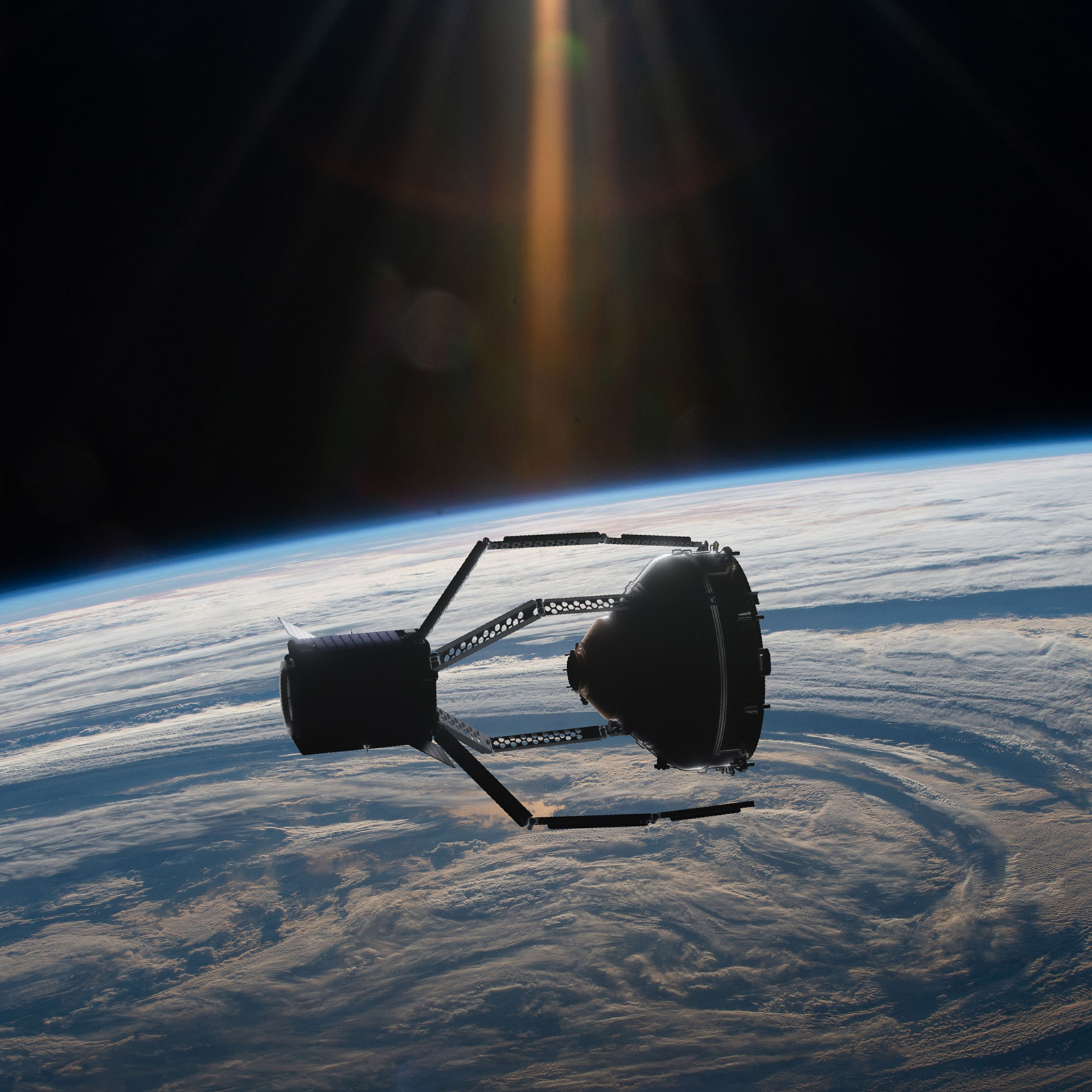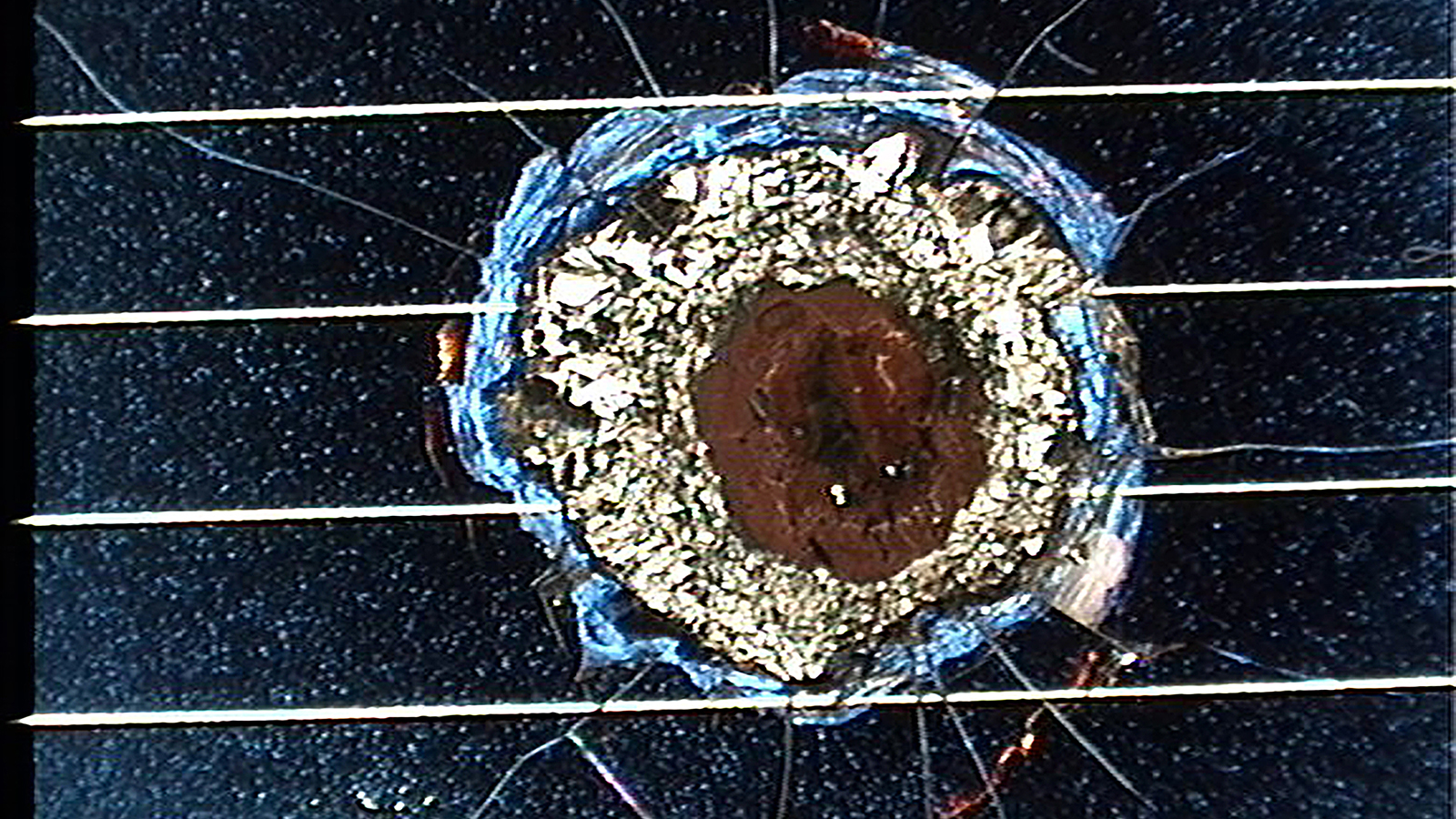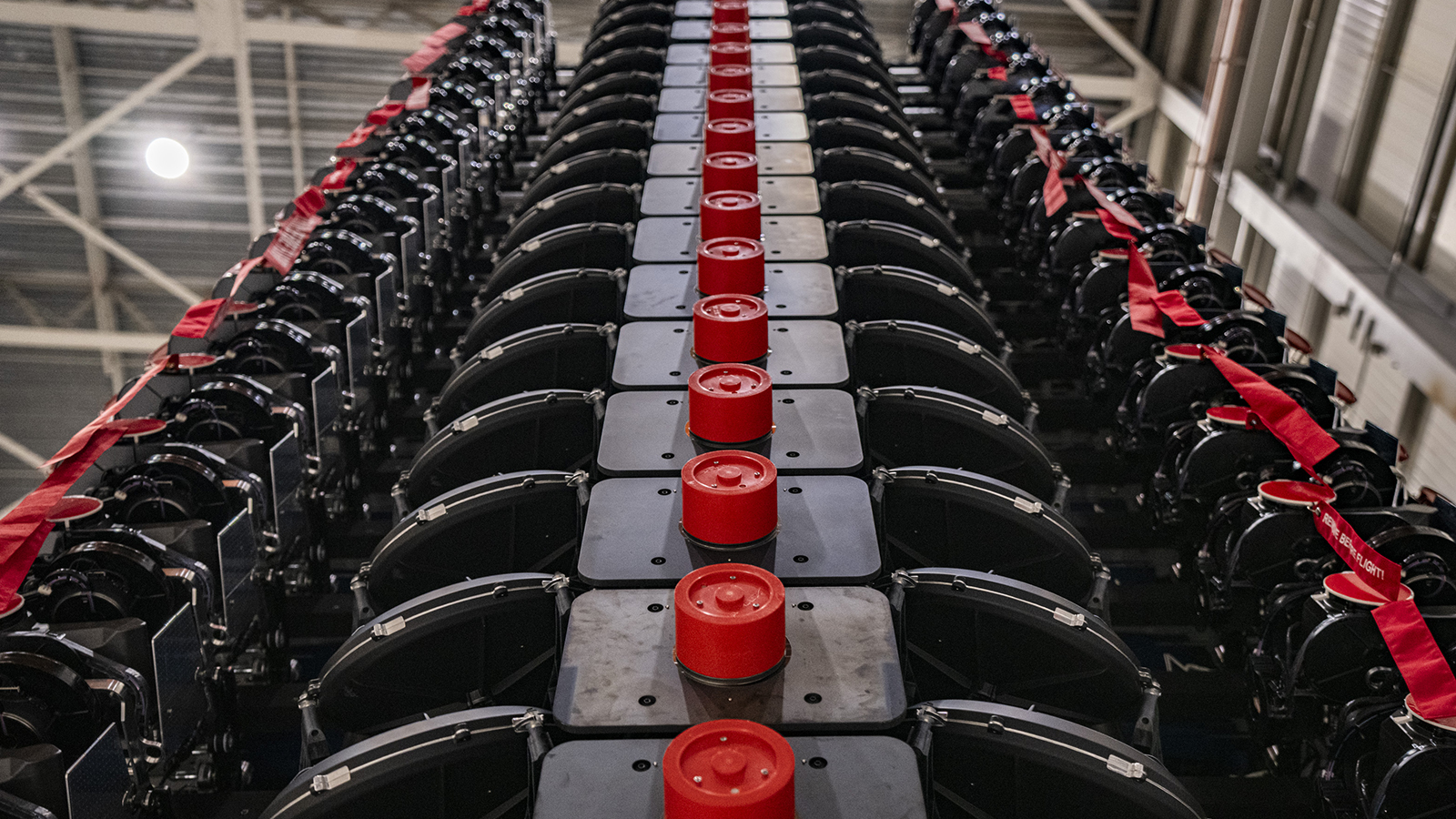Understanding the misunderstood Kessler Syndrome
By Jon Kelvey|March 2024
Nation-states are blowing up satellites. Companies are launching megaconstellations of thousands of satellites. Dead rocket stages whiz around the planet for years. And yet, the International Space Station hasn’t been destroyed, payloads reach deep space unharmed, and we’re not trapped on Earth — at least not by debris. Either calamity is not upon us or we just don’t recognize it. Jon Kelvey takes the measure of Kessler Syndrome.
Irony isn’t just limited to life in 1-g. Last year, a discarded payload adapter from a European Space Agency Vega rocket was orbiting Earth as it had for the past 10 years, when radars showed it had company — a small number of new objects traveling with it. ESA concluded that a “hypervelocity impact” with a piece of debris had broken fragments from the adapter.
Here’s the irony: ESA was preparing to dispatch a spacecraft to the adapter to demonstrate a technique for removing such debris, the goal being to reduce the odds of collisions that would make the trash problem worse.
The collision “actually shows how much we are running against the clock here,” says Portuguese engineer Tiago Soares. He’s the lead engineer at ESA’s Clean Space office, which helped conceive the planned cleanup demonstration, ClearSpace-1.
“We need to have reactive removal services available,” he says. Otherwise, debris could continue colliding with the growing number of spacecraft in orbit, producing more hazardous debris, and “it’s going to be much harder in the future to operate in space. There’ll be a lot more risks of losing satellites or losing a mission.”
Soares is referring to the Kessler Syndrome, a term inspired by the 1978 paper, “Collision frequency of artificial satellites: The creation of a debris belt,” in the Journal of Geophysical Research. It was written by Donald Kessler, a researcher in NASA’s Environmental Effects Office at Johnson Space Center in Houston, and a colleague at NASA Johnson, space scientist Burton Cour-Palais. They devised equations to model the distribution of known objects in orbit, predicting how likely they were to collide and create orbital debris over time.
My review of the literature and interviews with seven experts ranging from aerospace engineers to planetary scientists to astrodynamacists show that the scientific community hasn’t yet reached a consensus about whether the Kessler Syndrome has begun, or, if it has not begun, how bad it will be when it starts. There is consensus, however, that the basic concept is sound and that the space community needs to clean up its act.
For the moment, even the definition of “Kessler Syndrome” is open to debate. As Kessler, who retired decades ago, pointed out in a 2010 paper, it is “an orbital debris term that has become popular outside the professional orbital debris community without ever having a strict definition.”
In 2013, the term went mainstream in dramatic fashion in the film “Gravity.” A Russian missile destroys a satellite, spewing debris that collides with a space shuttle orbiter and the International Space Station, causing a cascade of collisions that take out all communications satellites in about 90 minutes.
That depiction was “Kessler Syndrome on steroids that defies physics,”says Abhishek Tripathi, director of mission operations at the UC Berkeley Space Sciences Lab.
That was one thing that all experts I spoke with agreed on: A Kessler Syndrome cascade is something that, whether it has begun or not, would play out over the course of decades if not centuries, rather than fitting into the runtime of a Hollywood drama.
For Tripathi’s part, he doesn’t think the syndrome has begun, and he doubts peaceful space operations will change that.
“A lot of things have to go wrong for us to end up in a Kessler Syndrome situation by slowly boiling the frog,” he says, referring to predictions of a slowly unfolding cascade. But: “We have the launch capacity to intentionally cause a Kessler Syndrome if we wanted to.”
Specifically, he worries about a nation-state kicking off a space war by knocking out satellites with missiles.
As for accidental collisions, meet physicist Mark Matney, whose first boss at NASA was none other than Kessler. Matney works in the Orbital Debris Program Office at NASA Johnson, and perhaps not surprisingly, he can rattle off the worst collisions to date. The most recent serious incident came in 2009 when an Iridium communications satellite and a Russian Cosmos satellite collided, generating some 2,000 pieces of debris at least 10 centimeters in diameter.
“I tell people that’s a harbinger of things to come,” Matney says.
In his view, Iridium-Cosmos was “the opening move” of the Kessler Syndrome: It is one of several unplanned collisions that have occurred, as Kessler predicted, and debris from Iridium-Cosmos could cause future collisions that grow debris, he warns. It’s difficult, Matney says, to look at orbit right now and say for certain that a cascade is in motion, because of the long time frame over which Kessler Syndrome would play out.
“I don’t think it’s acute yet,” he says, but “we’re on a timescale of something like a one in 10 chance each year of another major collision.”
He does not take comfort that it’s been 15 years and counting since the last big smashup — even if the gap might seem surprising, considering that today there are some 8,000 operational satellites in space compared to around 1,000 in 2009 and 300 in 1978. There’s also much more debris, in part because of the nation-state actions that Tripathi worries about. India destroyed a satellite with a missile in 2019 to demonstrate an antisatellite weapon, and Russia conducted a similar demonstration in 2021. Together, the two tests generated a little over 1,500 pieces of debris. Following the Russian shootdown, the seven crew members aboard ISS had to temporarily take shelter in their Crew Dragon and Soyuz capsules, in case the station was struck. Regarding satellite proliferation, while there are many more satellites, the company responsible for most of them, SpaceX, places its Starlink satellites in a low orbit so they can naturally deorbit relatively soon — within five or six years, per SpaceX — if they fail.
A long gap in time between collisions is not unique. Thirteen years before the Iridium-Cosmos collision, the French CERISE satellite broke up after colliding with a piece of debris from an Ariane 1 rocket. In 1991, the Russian Cosmos 1934 satellite collided with debris and broke up in orbit.
Somewhere in the middle in terms of views about Kessler Syndrome is Vishnu Reddy, an Earth and space scientist at the University of Arizona, where he also directs Space4, the university’s space safety, security and sustainability center. He questions the timing, not the plausibility of the Kessler Syndrome.
“I think we’re not there yet, but we’re approaching the situation very quickly,” he says. “The debate is about when it will happen, whether it is five years from now, 10 years from now or 20 years from now.”
Rather than relying on Kessler’s original mathematics and analysis, the experts are applying newer mathematics and models to simulate how debris and spacecraft interact in orbit — colliding or passing by each other — and how the debris created by collisions or events like the spontaneous explosion of an old rocket motor may increase the odds of further collisions and debris growth. In Massachusetts, Richard Linares, an astrodynamicist and professor at MIT, and his colleagues load the masses, volumes and velocities of known spacecraft and debris into the MIT Orbital Capacity Assessment Tool. MOCAT then calculates the motions of orbital objects forward in time.
“We can calculate how many objects are generated from a breakup event” — when an object explodes or disintegrates due to a collision — “and each object will have a size and a mass,” Linares says. “We can probably go up to 20 million objects in our simulation.”
MOCAT also runs Monte Carlo algorithms that take the positions and velocities of thousands of objects in orbit, among other information, and create myriad random simulations to show a range of potential future debris scenarios based on various parameters entered by the scientists. These include the number of rockets projected to reach orbit in a given year and a hypothetical number of major collisions between satellites occurring in the next 20 years.
“In those models, we see that we could have exponential growth [of debris] if the space traffic is too large,” Linares says.
That exponential growth is what could make accessing space a more risky and expensive affair, where certain orbital lanes could become so clogged they are no longer worth trying to operate within.
ESA and NASA use similar analytical approaches, ESA with its Debris Environment Long-Term Analysis software and NASA with its LEO-to-GEO Environment Debris software. Soares says ESA’s calculations suggest that orbital debris will continue to grow over the next two centuries even if all rocket launches stopped today.
“It would more than double the number of debris in orbit without us sending anything else up there,” he says.
In contrast, NASA’s modeling doesn’t predict exponential debris growth, according to Matney, but rather linear growth over the next 200 years — even if launches continue. But things get more complicated when you factor in that LEO isn’t a monolithic expanse, he says, and “in some altitude regions [debris growth] is exponential, some linear.”
At around 400 kilometers and into the 500-km realm — home to ISS and the SpaceX Starlink satellites among others — atmospheric drag plays a major role. Dead satellites and debris usually slow and burn up in the atmosphere in just a few years. This natural cleansing process accelerates when the sun becomes more active and solar coronal mass ejections strike Earth and cause the atmosphere to swell.
“In those altitudes, we can probably do a lot and we will be forgiven,” Linares says.
But this atmospheric drag drops off quickly as one goes higher. By the time you get around 600 km, the altitude of the Hubble Space Telescope, “now you’re talking about decades for things to drag down,” Matney says.
“When you get up to 800 or 900 km, we’re now talking about centuries for things to drag down,” he adds. “When we get up to 1,000 km, you’re talking about millennia.”
A lot of satellites fly in those higher altitudes already, including some 70 Iridium communications satellites, at least 600 OneWeb broadband internet satellites and NASA’s Earth-observation spacecraft, including Landsat 8 and 9.
“If there are collision events,” Linares says, “those altitudes can very quickly turn into a Kessler type of scenario where they grow very rapidly into millions upon millions [of pieces] of debris.”
However, humanity would not be “locked in” on Earth in such an event, he says, given that crewed spacecraft headed for deep space would cross the problematic altitudes so quickly. But there are still plausible scenarios that are far from ideal. Linares sees a potential future where “humans probably don’t have any incentive to launch satellites, because we’re losing 50% of them” to collisions with debris, he says.
Matney puts it like this: Kessler Syndrome “won’t cause orbital altitudes to be unusable. It’s more like a gradual degradation that’s going to cost everybody more money.”
The prospect of losing money leads naturally to the question of just what should be done about orbital debris, and there are two generally agreed-upon major actions to take.
“The first step is to make sure that new junk doesn’t get added,” says Reddy, the University of Arizona professor. “The second step is to remove large pieces of junk that have the potential to be the sources of cascading debris events in a Kessler Syndrome scenario.”
Not creating new debris is largely a matter of adhering to the rule in the United States and Europe that satellites must not stay in orbit longer than five years after their mission is completed.
“It’s the stuff you learn in kindergarten: You clean up your messes; don’t hurt your neighbor,” Matney says.
Removing existing space junk could have the biggest impact on the debris curve. “It depends on how much remediation you do, but in principle, it actually flattens it out and starts letting it go down,” he says.
That’s why ESA isn’t giving up on ClearSpace-1, or the idea behind the mission. Soares, the lead engineer, notes that ESA had its Copernicus satellites built with interfaces so they can be grabbed and redirected to deorbit should they fail. Eventually, he says, the goal is to build spacecraft that can grapple and remove large objects that pose a major debris hazard, such as ESA’s multiton Envisat, which died in 2012.
“It’s not easy because the satellite was not at all designed to be removed,” Soares says.
No matter which view of the Kessler Syndrome one adheres to, the risk it describes might not be a fait accompli. “This is a problem that we have the capability and, hopefully, the willpower to solve,” says Matney.











